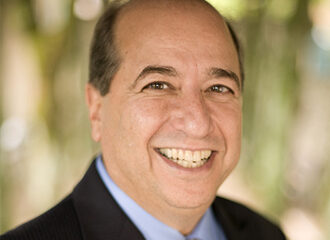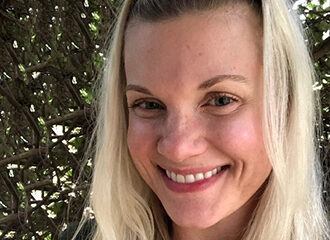Written by: Ashley Vicari, NCC, LCP (she/her)
Professional Relations Regional Manager, The Renfrew Center
 Anorexia treatment is a non-linear journey that’s different for everyone. In this post, we explore the various levels of care, timelines for treatment, how to get started, and what to focus on during your own journey.
Anorexia treatment is a non-linear journey that’s different for everyone. In this post, we explore the various levels of care, timelines for treatment, how to get started, and what to focus on during your own journey.
“How long will this process take?” is a question I hear often and honestly, I understand why. It would be so nice to know that this complicated and challenging experience has an end date. It would be nice to know how long treatment will take, how long you will be out of school, out of work, etc.
The truth is, no journey looks the same and while I cannot give you an explicit expiration date for your eating disorder, what I can offer is this: with therapeutic support, community, and available tools, you can begin your healing process.
What Is Anorexia?
Anorexia Nervosa is a mental health disorder which is characterized by restriction of food/caloric intake, an intense fear of weight gain, as well as high levels of body dissatisfaction. As with most eating disorders, there is often underlying emotional distress coupled with the eating disorder. This distress can come in the diagnosable forms of co-occurring anxiety, depression, OCD, or even PTSD.
It is important to connect with a professional if you might be experiencing any of these symptoms, as a trained eating disorder therapist can provide a thorough assessment to diagnose the eating disorder as well as any other mental health diagnoses traveling with it. They will also recommend which level of care would best fit your specific medical and psychological needs.
What Does Anorexia Treatment Involve?
In therapy, you and your therapist will work together to identify your goals and design a treatment plan to achieve them. You will likely gain awareness, discover your patterns, and work towards shifting some behaviors that are maintaining your distress. It is important to remember that anorexia is NOT your fault! While therapy may feel daunting especially if you have never experienced it before, research suggests that the sooner someone can receive counseling and intervention, the quicker their recovery process may be. (Lievers et al., 2009)
How Do I Start the Treatment Process?
There are many roads to healing, but without the appropriate level of support, some roads can be much more difficult than others. The symptoms of anorexia can often become so consuming and unmanageable that many discover that it’s necessary to seek professional support and structure from both medical and mental health providers.
If you’re fortunate enough to access treatment, scheduling an assessment with a qualified eating disorder specialist is the first step in determining the level of care that best matches your needs and treatment goals. Some folks will start at the outpatient level of care, attending weekly individual sessions with a therapist. An eating disorder therapist will likely recommend that you increase your circle of help by referring you to a dietitian, a psychiatrist, and even a primary care physician who are all well versed in working with eating disorders. This group of professionals is what we call your treatment team, and they often collaborate with you and with each other to ensure they are delivering the best care.
Tired of reading? Check out our podcast episode: How Do You Treat an Eating Disorder? A Stimulating Conversation with Dr. Melanie Smith, Director of Training at the Renfrew Center.
Once your treatment team is established, it can be helpful to grow your circle of support by getting involved in some sort of community. In fact, a “felt sense of community” is a protective factor against severe mental health challenges including suicidal ideation. This can look like telling a few trusted family members, parents, partners, siblings, friends, etc. about what you are experiencing and asking them to help you move forward in your process of recovery. Perhaps someone can attend a family session with you or eat a meal with you. If this is a person that you trust to hold space for you when you are having a hard time, it is okay to open up to them. Brene Brown would remind us that vulnerability drives out shame and Dan Siegel would remind us that naming our problems helps to tame our problems. So, build that inner circle as much as you can.
Lastly, building community can also look like getting involved in a support group. Your local Renfrew often has recovery or support groups available or can certainly direct you to someone who may be running one. Sharing space with people who are on a similar journey helps to normalize our experiences as well as teach us the helpful strategies others use in their own recovery. Who knows, you may even find a lifelong friend in group.
What Should I Focus on During Treatment?
Once you have your support team in place, it’s time to begin putting all your hard work into practice. Here are a few tools for your recovery tool belt. Remember, these tools may not be quick fixes, but they may help you in continuing to build awareness and practice helpful management of your emotions.
- Journal about what your mind and body may be needing at the current moment. Are you feeling lonely, overwhelmed, tired, angry, etc.? Practice noticing your emotions and remember that our emotions serve to tell us our bodies need something. If we are feeling lonely, perhaps we need to connect with someone. If we are feeling angry, perhaps a boundary has been crossed and we need to vocalize it.
- Return to your breath. Your breath is a tool that you can take anywhere. Breathe in for four counts, hold for four counts, breathe out for four counts, and hold for four counts. This is called square breathing, and it is one of many breathing techniques you can use to regulate your autonomic nervous system in a moment of emotional dysregulation.
- Sit in your emotion. I know that doesn’t sound like fun, but acknowledging you are experiencing an emotion and allowing yourself to practice being there really does teach your body that YOU CAN DO HARD THINGS. The more you practice tolerating the uncomfortable emotion, the less it will bother you.
- Notice your progress. Recovery is a journey, and some days will feel easier than others. AND, yay you for coming this far! Therapy, vulnerability, using your tools – it’s all hard work! Keep taking steps. Some days you may move an inch, and some days you will progress much further!
- Don’t forget to voice your needs. Did you know that it’s okay to be needy? We all have needs and it is imperative that we notice them on our journey.
Conclusion
Recovery from anorexia nervosa will likely be a unique, non-linear journey with a different timeline for everyone. There are various levels of care for anorexia, and the level that best fits your needs will depend on many different factors at the time of the assessment. The length of your treatment depends on many factors as well, including the medical and emotional goals developed by you and your team.
Is recovery possible? Yes! There are many people living full and fulfilling lives in recovery. Will there be days that feel more challenging than others? Yes! Can you, do it? Yes! Recovery really does exist! Recovery says that even on days your body image plummets, you can still walk in recovery. Even on days food feels challenging, you can still walk in recovery. Even on days that you need to pick up the phone and call your treatment team, you can still walk in recovery. Recovery is fluid and healing is available.


